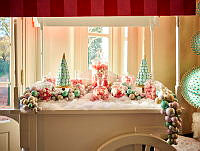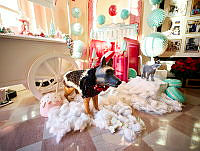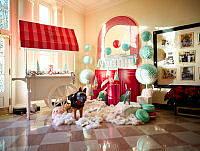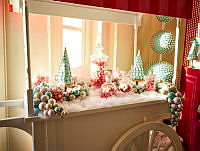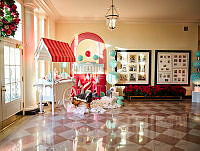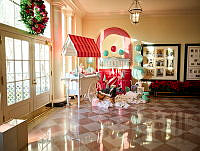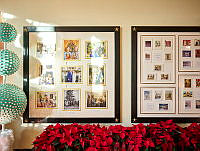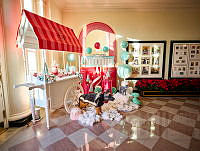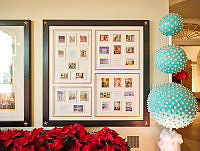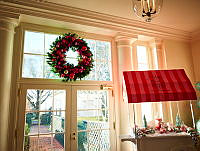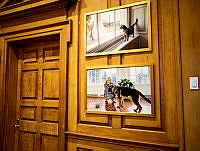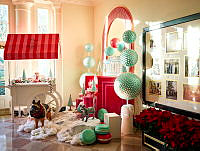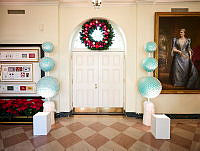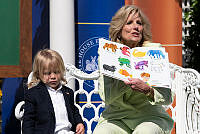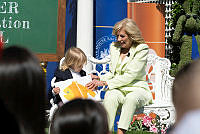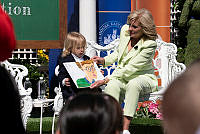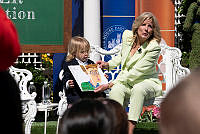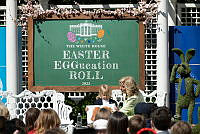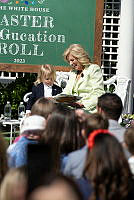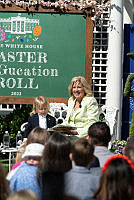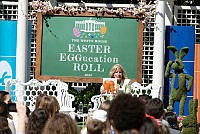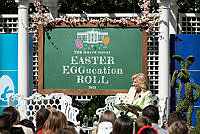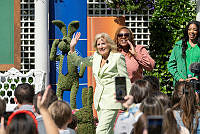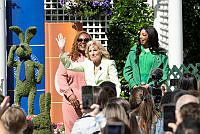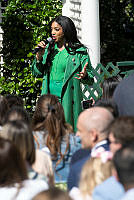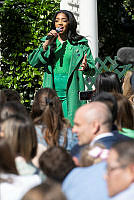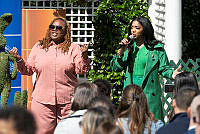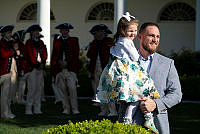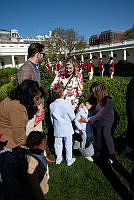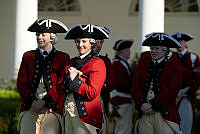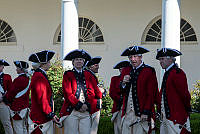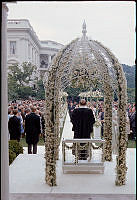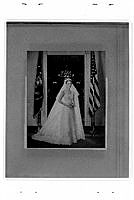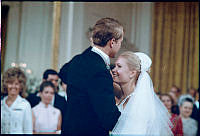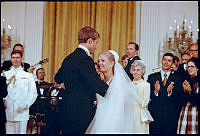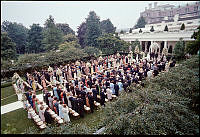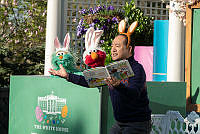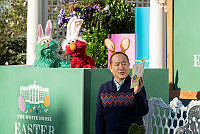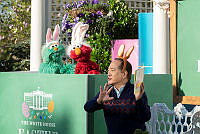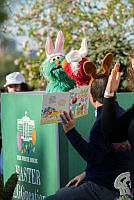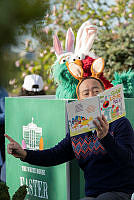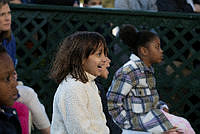The White House Garden Tours
A Legacy of First Lady Patricia Nixon
Copyright © April 9, 2019 White House Historical Association. All rights reserved under international copyright conventions. No part of this article may be reproduced or utilized in any form or by any means, electronic or mechanical, including photocopying, recording, or by any information storage and retrieval system, without permission in writing from the publisher. Requests for reprint permissions should be addressed to books@whha.org

This photograph is of the South Portico as seen from the lit fountain on the South Lawn of the White House. White House photographer Karl Schumacher took this photo on the evening of December 1, 1970, during the administration of Richard M. Nixon.
Richard Nixon Presidential Library and Museum/NARAWhen the White House gates open at 10:00 am on Saturday, April 13th, thousands of people will stream through for the start of the 2019 White House Spring Garden Tour. Few of them will know that this special tour – one of only two weekends each year that the grounds of the President’s House are open to the general public – is part of the legacy of First Lady Patricia Nixon.
During her service as First Lady (1969-74), Mrs. Nixon undertook numerous initiatives to make the White House more accessible to visitors from across the country and around the world. Much of her attention was focused on the interior of the mansion itself – increasing its collection of historic furnishings, making it handicapped accessible, and developing special tours for blind and deaf tourists, among others.
But Pat Nixon didn’t limit her efforts to the interior of the White House. An avid gardener, she was also interested in making the White House’s historic gardens and grounds more accessible to the public.

First Lady Patricia Nixon leads Mayor-Commissioner of Washington, D.C. Walter Washington and a group of schoolchildren through the Jacqueline Kennedy Garden on April 14, 1973.
Richard Nixon Presidential Library and Museum/NARAHer focus started with making it easier for the White House to be visible after dark. Unlike the Jefferson and Lincoln Memorials, the Washington Monument, and other landmarks in the nation’s capital, the White House had never been illuminated at night. First Lady Patricia Nixon decided to change that.
She worked closely with the National Park Service, which is responsible for the White House Grounds, to develop the plan for appropriate exterior lighting. The cost of installing the lighting fixtures was covered by private funds remaining from those raised for the 1969 Presidential inaugural festivities. As a result of her vision, the people’s house has been illuminated every night since Mrs. Nixon ceremoniously turned on the lights on November 25, 1970.
Mrs. Nixon also began the practice of keeping the American flag flying over the White House 24 hours a day, every day. Previously, the flag was brought down every evening at sunset and raised again at sunrise the next day. It took a Presidential Proclamation to authorize the change, which President Nixon issued at Mrs. Nixon’s urging, on September 4, 1970.1

First Lady Patricia Nixon leads Mayor-Commissioner of Washington, D.C. Walter Washington and a group of schoolchildren along the South Drive on April 14, 1973. The students were winners of a poster contest sponsored by the Society for a More Beautiful Capital, an organization founded by Mary Lasker and First Lady "Lady Bird" Johnson in 1964.
Richard Nixon Presidential Library and Museum/NARAMrs. Nixon next turned her attention to the White House Grounds themselves. Since 1878, the South Lawn had been opened nearly every year to young children and their families for the annual Easter Egg Roll. And throughout much of the 19th century and in the early part of the 20th century, people could stroll the grounds unescorted. Never before, however, had the grounds been opened for an informative tour that would, in Mrs. Nixon’s words, allow visitors to “share with us their present beauty and past history.”2
Mrs. Nixon planted the seeds for the first Garden Tour in early 1972. Michael J. Farrell, who headed the White House Visitors Office, outlined Mrs. Nixon’s vision for the first Garden Tour in a brief memo. The tour would include the Rose Garden, much of the South Grounds, and the Jacqueline Kennedy Garden. Visitors would receive a brochure that provided an overview of the grounds, and a military band would play during the tour.
The scope of the tour expanded during the planning process. Small groups of visitors would be allowed to walk through the Children’s Garden, gifted by the President Lyndon B. Johnson and First Lady Lady Bird Johnson shortly before they left Washington in January 1969, and the Ground Floor corridor and the rooms on the State Floor of the White House would also be open.

First Lady Patricia Nixon points out and explains photograph displays along the South Drive on April 14, 1973.
Richard Nixon Presidential Library and Museum/NARAConsiderable energy went into making the first Garden Tour a success. Under Mrs. Nixon’s direction, the Visitors Office coordinated the effort, involving many other White House offices. The photography office produced oversized photos of various events that took place on the grounds. The White House carpenters shop built the easels on which the photographs and signs highlighting special points of interest (such as commemorative trees) were placed. The Social Secretary’s office arranged for music. And Irvin Williams (who served as head gardener at the White House from 1962-2008) and Bill Ruback of the National Park Service would be on hand during the tour to answer visitors’ questions.
By the time the Garden Tour kicked-off, more than fifty different people were involved in planning and carrying out this first-ever Garden Tour. To show her appreciation for their effort, Mrs. Nixon personally inscribed and signed copies of the brochure for each person involved in creating this new White House event.
When the first day of the tour arrived, the sky was clear and sunny and the temperatures were cool – perfect weather for enjoying the White House gardens and grounds. Mrs. Nixon kicked off the tour, leading the mayor-commissioner of Washington, D.C., Walter Washington, and a group of local schoolchildren through the grounds. Among the students was, Duane Bolton, the first-place winner of a poster contest sponsored by the Society for a More Beautiful National Capital. Two families who were waiting in line were also invited to join the First Lady’s tour.

Duane Bolton, first-place winner of the poster contest sponsored by the Society for a More Beautiful Capital, presents his poster to First Lady Patricia Nixon and President Richard Nixon on April 14, 1973.
Richard Nixon Presidential Library and Museum/NARAStarting in the Jacqueline Kennedy Garden, First Lady Patricia Nixon escorted her group around the grounds. As they walked, she pointed out such historic elements of the landscape as the Jefferson Mounds, which our third president is said to have created to provide visual interest to the otherwise flat lawn, various trees planted by presidents ranging from an American Elm planted by the sixth president, John Quincy Adams, to a Giant Sequoia planted by California native, President Richard Nixon, and the colorful spring flowers blooming around the fountain.
After walking along the South Drive, the group entered the Rose Garden, where they were joined by President Nixon. As they entered the Rose Garden, they passed by the towering Southern Magnolia. According to legend, it was planted by President Andrew Jackson in 1829 as a tribute to his late wife, who died shortly before Jackson became president.
By the time the first White House Garden Tour concluded the next day, nearly 11,500 people had helped launch a tradition that continues to this day. In the 46 years since, as many as one million people have walked the grounds during the spring and fall White House Garden Tours. And over the years, the White House Grounds have continued to evolve.

President Richard Nixon speaks with Duane Bolton near the Rose Garden during First Lady Patricia Nixon's White House gardens tour on April 14, 1973.
Richard Nixon Presidential Library and Museum/NARAThe American Elm planted by John Quincy Adams in 1826 finally succumbed to old age. In 1991, it was replaced by a seedling raised from that tree, planted by First Lady Barbara Bush. In 2009, First Lady Michelle Obama planted the White House Kitchen Garden to provide “home-grown” fresh, organic vegetables for the first family. In late 2017, the Jackson Magnolia was severely cut back as its branches grew so weak they proved to be a safety hazard. First Lady Melania Trump made sure, however, that wood removed was saved and that seedlings were propagated that could, one day, replace the ancient tree. And every president since the first Garden Tour has added at least one new tree to the White House Grounds.
One thing hasn’t changed, however. The tradition of opening the White House gardens and grounds to the public, started by First Lady Patricia Nixon in 1973, continues to delight visitors. Thanks to her vision, as visitors amble through the White House grounds, they are following in the footsteps of every president and first lady since President John Adams and First Lady Abigail Adams became the first residents of the White House in November 1800.
To learn more about the White House grounds, see The White House Garden by William Seale, published by the White House Historical Association. Memoranda about the planning for the Garden Tour are in the collections of the Richard Nixon Presidential Museum and Library of the National Archives, Yorba Linda, California.

First Lady Patricia Nixon and President Richard Nixon walk through the Rose Garden with schoolchildren on April 14, 1973.
Richard Nixon Presidential Library and Museum/NARA













